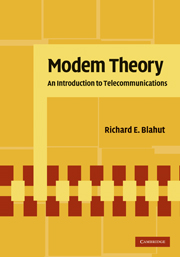Book contents
- Frontmatter
- Contents
- Preface
- Dedication
- 1 Introduction
- 2 Baseband Modulation
- 3 Baseband Demodulation
- 4 Sequences at Baseband
- 5 Passband Modulation
- 6 Passband Demodulation
- 7 Principles of Optimal Demodulation
- 8 Synchronization
- 9 Codes for Digital Modulation
- 10 Codes for Data Transmission
- 11 Performance of Practical Demodulators
- 12 Secure Communications
- Bibliography
- Index
11 - Performance of Practical Demodulators
Published online by Cambridge University Press: 05 June 2012
- Frontmatter
- Contents
- Preface
- Dedication
- 1 Introduction
- 2 Baseband Modulation
- 3 Baseband Demodulation
- 4 Sequences at Baseband
- 5 Passband Modulation
- 6 Passband Demodulation
- 7 Principles of Optimal Demodulation
- 8 Synchronization
- 9 Codes for Digital Modulation
- 10 Codes for Data Transmission
- 11 Performance of Practical Demodulators
- 12 Secure Communications
- Bibliography
- Index
Summary
We have studied in great detail the effect of additive gaussian noise in a linear system because of its fundamental importance. Usually the ultimate limit on the performance of a digital communication system is set by its performance in gaussian noise. For this and other reasons, the demodulators studied in Chapter 3 presume that the received waveform has been contaminated only by additive gaussian noise. However, there are other important disturbances that should be understood. The demodulators studied in Chapter 4 extend the methods to include intersymbol interference in the received waveform. While additive gaussian noise and intersymbol interference are the most important channel impairments, the demodulator designer must be wary of other impairments that may affect the received signal. The demodulator must not be so rigid in its structure that unexpected impairments cause an undue loss of performance. This chapter describes a variety of channel impairments and methods to make the demodulator robust so that the performance will not collapse if the channel model is imperfect.
Most of the impairments in a system arise for reasons that are not practical to control, and so the waveform must be designed to be tolerant of them. Such impairments include both interference and nonlinearities. Sometimes nonlinearities may be introduced intentionally into the front end of the receiver because of a known, desired outcome. Then we must understand the effect of the nonlinearity in all its ramifications in order to anticipate undesirable side effects.
- Type
- Chapter
- Information
- Modem TheoryAn Introduction to Telecommunications, pp. 399 - 452Publisher: Cambridge University PressPrint publication year: 2009



